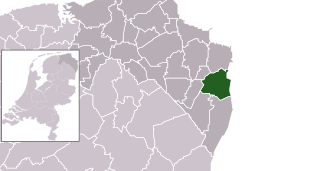
Bellingwedde was a municipality with a population of data missing in the province Groningen in the northeast of the Netherlands. Bellingwedde was established in 1968, when the municipalities of Bellingwolde and Wedde had merged. It contained the villages Bellingwolde, Blijham, Oudeschans, Veelerveen, Vriescheloo, and Wedde. After almost 50 year, Bellingwedde was disestablished in 2018, when the municipalities of Bellingwedde and Vlagtwedde had merged into Westerwolde.

Kerkrade is a town and a municipality in the southeast of Limburg, the southernmost province of the Netherlands. It forms part of the Parkstad Limburg agglomeration.

Nieuw-Lekkerland is a town in the western Netherlands, in the province of South Holland. It is situated on the southern shores of the Lek River, in the north-west of the Alblasserwaard.

Heusden was a municipality located in the Belgian province of East Flanders. In 1977 it merged with the municipality of Destelbergen, of which it is now part.

Herzogenrath is a municipality in the district of Aachen in the German state of North Rhine-Westphalia. It borders the Dutch town of Kerkrade, the national border in one section running along the middle of a main road and even directly through the centre of the cross-border Eurode office complex.
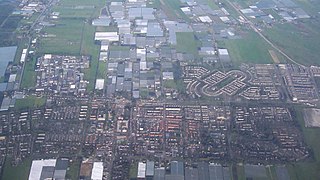
Pijnacker is a town in the Dutch province of South Holland. It is bordered by Zoetermeer to the north, by Nootdorp to the northwest, by Delfgauw to the southwest, by Rotterdam to the south and by Berkel en Rodenrijs to the east.

The Martinikerk is the oldest church in Groningen, Netherlands. The church and its associated tower are named after Saint Martin of Tours (316–397), the patron saint of the Bishopric of Utrecht to which Groningen belonged.

A rijksmonument is a national heritage site of the Netherlands, listed by the agency Rijksdienst voor het Cultureel Erfgoed (RCE) acting for the Dutch Ministry of Education, Culture and Science.

West-Terschelling is the largest village on Terschelling in the province Friesland, the Netherlands. It had a population of around 2,602 in January 2017.

Herkenrode Abbey was a Catholic monastery of Cistercian nuns located in Kuringen, part of the municipality of Hasselt, which lies in the province of Limburg, Belgium.

De Baarsjes is a district in Amsterdam-West situated west of the city center of Amsterdam, Netherlands. Named after a former hamlet, urban development started in the 1920s. It contains the neighbourhoods Admiralenbuurt, Chassébuurt, Postjesbuurt, and Trompbuurt.
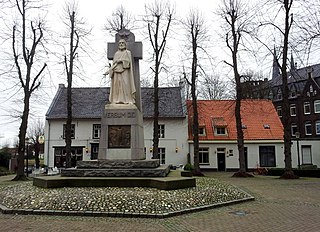
Steyl is a village in the Tegelen district of the municipality of Venlo, the Netherlands. The village on the river Meuse is mainly known for its monasteries. In 2004, a section of the village including four monasteries was made a conservation area under protection of the Dutch heritage agency Rijksdienst voor het Cultureel Erfgoed.

The Dorpskerk also known as the Maartenskerk in Ouddorp was completed in 1348 and is situated in the town's centre. The tower was completed in the early 16th-century. The church was completely renovated in the 18th-century. The church and tower are rijksmonuments, listed as number 16267 and 16268.
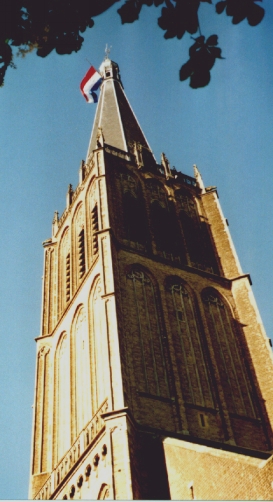
The Martinikerk is a church in Doesburg, Netherlands. The church's tower is the eighth tallest in the Netherlands at 94 metres (308 ft).

Het Oude Loo is a 15th-century castle on the estate of Het Loo Palace in Apeldoorn in the Netherlands. The castle was built as a hunting lodge and is surrounded by a moat. The castle is currently used by the Dutch royal family as a country house and guest residence. It is not open to the public.
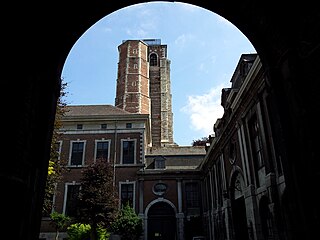
Sint-Truiden Abbey or St Trudo's Abbey is a former Benedictine monastery in Sint-Truiden in the province of Limburg, Belgium. The abbey was founded in the 7th century and was one of the oldest and most powerful in the Low Countries. The town of Sint-Truiden grew up around it. The great Romanesque abbey church, dedicated to Saint Remaclus and Saint Quintin, was demolished in 1798, four years after the suppression of the abbey.

The Saint Hippolytus Chapel is a chapel in the old city of Delft. It is one of the oldest buildings in Delft, and since 1967 it has been designated the Rijksmonument.

Schoterveense Molen is a windmill in Haarlem located at Wipwatermolen Heussensstraat in the former municipality of Schoten. It is registered as a Rijksmonument.
MSDS Marine is a British marine and coastal contractor that specialises in the management, execution and support of archaeological projects in the marine environment. The company also engages in outreach to educate the public about marine and coastal heritage and environments and provides opportunities for volunteering.

Aldendriel Castle is late medieval castle in Mill, North-Brabant, Netherlands





























